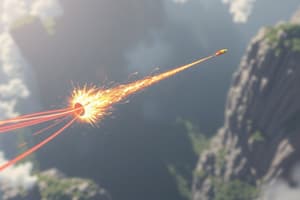Podcast
Questions and Answers
In the bottle cap experiment, what is the primary factor influencing the horizontal distance traveled by the bottle cap projected with an initial horizontal velocity?
In the bottle cap experiment, what is the primary factor influencing the horizontal distance traveled by the bottle cap projected with an initial horizontal velocity?
- The initial horizontal velocity imparted to the cap. (correct)
- The air resistance experienced by the cap.
- The height from which the cap is released.
- The gravitational force acting on the cap.
Considering the bottle cap experiment, if both bottle caps are released simultaneously, what factor determines whether they will hit the ground at the same time?
Considering the bottle cap experiment, if both bottle caps are released simultaneously, what factor determines whether they will hit the ground at the same time?
- The air pressure in the room.
- The mass of the bottle caps.
- The initial horizontal velocity of one cap.
- The vertical distance they fall. (correct)
When a ball is launched horizontally from a cliff, which component of its velocity remains constant throughout its flight, assuming negligible air resistance?
When a ball is launched horizontally from a cliff, which component of its velocity remains constant throughout its flight, assuming negligible air resistance?
- Vertical velocity.
- Horizontal velocity. (correct)
- Tangential velocity.
- Resultant velocity.
For a ball launched horizontally off a cliff, what causes the vertical velocity to change over time?
For a ball launched horizontally off a cliff, what causes the vertical velocity to change over time?
A ball is launched horizontally from a cliff with an initial velocity of 25 m/s. What will its horizontal velocity be 2 seconds after launch, assuming air resistance is negligible?
A ball is launched horizontally from a cliff with an initial velocity of 25 m/s. What will its horizontal velocity be 2 seconds after launch, assuming air resistance is negligible?
If a ball is launched horizontally from a cliff, and it takes 3 seconds to hit the ground, what information is needed to calculate the height of the cliff?
If a ball is launched horizontally from a cliff, and it takes 3 seconds to hit the ground, what information is needed to calculate the height of the cliff?
A projectile is launched horizontally. How does the vertical acceleration change during its flight, assuming negligible air resistance?
A projectile is launched horizontally. How does the vertical acceleration change during its flight, assuming negligible air resistance?
Two balls are released simultaneously from the same height. One is dropped vertically, and the other is projected horizontally. Which ball will hit the ground first, assuming flat ground and negligible air resistance?
Two balls are released simultaneously from the same height. One is dropped vertically, and the other is projected horizontally. Which ball will hit the ground first, assuming flat ground and negligible air resistance?
If a ball is launched horizontally off a cliff with a greater initial velocity, what will be the effect on the time it takes to hit the ground, assuming the height of the cliff remains the same?
If a ball is launched horizontally off a cliff with a greater initial velocity, what will be the effect on the time it takes to hit the ground, assuming the height of the cliff remains the same?
What is the shape of the trajectory of a ball launched horizontally from a cliff, assuming negligible air resistance?
What is the shape of the trajectory of a ball launched horizontally from a cliff, assuming negligible air resistance?
In projectile motion, at what angle should a projectile be launched to achieve the maximum horizontal range, neglecting air resistance and assuming a flat surface?
In projectile motion, at what angle should a projectile be launched to achieve the maximum horizontal range, neglecting air resistance and assuming a flat surface?
A projectile is fired at an angle. What is the vertical velocity at the highest point of its trajectory, assuming we are neglecting air resistance?
A projectile is fired at an angle. What is the vertical velocity at the highest point of its trajectory, assuming we are neglecting air resistance?
How does increasing the launch angle (from 0 to 90 degrees) affect the time a projectile spends in the air, assuming the same initial speed?
How does increasing the launch angle (from 0 to 90 degrees) affect the time a projectile spends in the air, assuming the same initial speed?
Which of the following factors does NOT affect the range of a projectile on level ground, neglecting air resistance?
Which of the following factors does NOT affect the range of a projectile on level ground, neglecting air resistance?
Neglecting air resistance, what happens to the kinetic energy of a projectile as it reaches its maximum height?
Neglecting air resistance, what happens to the kinetic energy of a projectile as it reaches its maximum height?
Under what conditions is the range of a projectile the same for two different launch angles?
Under what conditions is the range of a projectile the same for two different launch angles?
A projectile is launched upwards at an angle. At which point in its trajectory is its speed the lowest?
A projectile is launched upwards at an angle. At which point in its trajectory is its speed the lowest?
Suppose a projectile is launched with the same initial velocity on both Earth and the Moon (where gravitational acceleration is weaker). How would the range and maximum height compare, neglecting air resistance?
Suppose a projectile is launched with the same initial velocity on both Earth and the Moon (where gravitational acceleration is weaker). How would the range and maximum height compare, neglecting air resistance?
In a projectile motion scenario, which of the following quantities remains constant throughout the motion (assuming no air resistance)?
In a projectile motion scenario, which of the following quantities remains constant throughout the motion (assuming no air resistance)?
Two projectiles are launched with the same initial speed. Projectile A is launched at an angle of 30 degrees, while Projectile B is launched at an angle of 60 degrees. Which projectile will reach a greater maximum height, assuming level ground and negligible air resistance?
Two projectiles are launched with the same initial speed. Projectile A is launched at an angle of 30 degrees, while Projectile B is launched at an angle of 60 degrees. Which projectile will reach a greater maximum height, assuming level ground and negligible air resistance?
Flashcards
Projectile Motion
Projectile Motion
Motion where an object is launched into the air and follows a curved path due to gravity.
Initial Velocity
Initial Velocity
The initial speed and angle at which a projectile is launched.
Acceleration Due to Gravity
Acceleration Due to Gravity
The constant acceleration experienced by objects due to Earth's gravitational pull.
Horizontal Velocity
Horizontal Velocity
Signup and view all the flashcards
Vertical Velocity
Vertical Velocity
Signup and view all the flashcards
Range
Range
Signup and view all the flashcards
Study Notes
- The text provides instructions for a physics activity comparing the motion of two objects falling under gravity.
- One object falls freely, while the other is horizontally projected.
- Additionally, the activity also illustrates projectile motion concepts.
Activity: Compare Me
- Materials: Two plastic bottle caps and a plastic ruler are needed.
- Setup: Place the ruler on a table as shown in the diagram.
- Position one bottle cap on one edge of the ruler and the other on the opposite edge.
- Procedure: Push the ruler forward so that both caps fall.
- Observe the motion of the bottle caps as they fall and hit the floor.
- Determine if the bottle caps hit the floor at the same time or at different times, and provide reasoning for your observation.
- Key points: One bottle cap falls freely with no initial horizontal velocity.
- The other bottle cap is projected horizontally with an initial horizontal velocity.
- Horizontally projected projectile covers some horizontal distance from the point of release
Problem Solving: Projectile Motion
- A ball is launched horizontally from a cliff with an initial velocity of 25 m/s.
- The trajectory of the ball is shown in the diagram.
- The problem requires us to determine the horizontal and vertical velocities at different times.
Horizontal Velocity (vx)
- The horizontal velocity remains constant throughout the motion, assuming negligible air resistance.
- At t = 0 sec, vx = 25 m/s.
- At t = 1 sec, vx = 25 m/s.
- At t = 2 sec, vx = 25 m/s.
- At t = 3 sec, vx = 25 m/s.
- At t = 4 sec, vx = 25 m/s.
- At t = 5 sec, vx = 25 m/s.
- The horizontal velocity (vx) of the ball is 25 m/s in every time interval of 1 second.
Vertical Velocity (vy)
- The vertical velocity changes due to gravity (acceleration due to gravity = -9.8 m/s²).
- At t = 0 sec, vy = 0 m/s.
- At t = 1 sec, vy = -9.8 m/s.
- At t = 2 sec, vy = -19.6 m/s.
- At t = 3 sec, vy = -29.4 m/s.
- At t = 4 sec, vy = -39.2 m/s.
- At t = 5 sec, vy = -49.0 m/s.
- The vertical velocity (vy) of the ball increases by -9.8 m/s every second of fall (due to gravity).
Studying That Suits You
Use AI to generate personalized quizzes and flashcards to suit your learning preferences.




